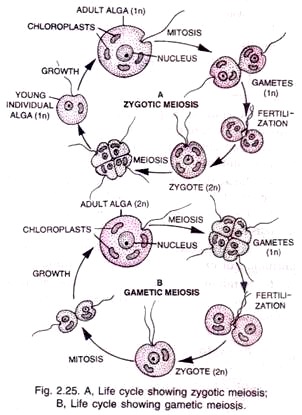The following points highlight the two important methods of reproduction in protists. The methods are: 1. Asexual Reproduction 2. Sexual Reproduction.
Method # 1. Asexual Reproduction:
It involves only one parent. All the young ones produced asexually have the same genetic constitution as that of the parent and are called clones.
Asexual reproduction can occur in the following ways:
(i) Binary Fission:
It is the division of the parent body into two equal daughter individuals by mitosis. Examples: Amoeba, Euglena and Paramecium.
(ii) Multiple Fission:
It is the division of the parent organism into several daughter individuals. Examples: Amoeba and Plasmodium.
(iii) Plasmotomy:
It is the division of the multinucleate protist into two or more multinucleate offspring by the division of cytoplasm without nuclear division. It occurs in Opalina.
(iv) Spore Formation:
In some protists spores are formed for asexual reproduction. Spores have some sort of covering to withstand un-favourable conditions. On germination, each spore gives rise to a new individual. Example: Slime moulds.
(v) Budding:
In budding a small outgrowth develops from the parent body which separates and develops into a new individual. Example: Arcella (a sarcodine)
Method # 2. Sexual Reproduction:
It originated in protists. Sexual reproduction involves two fundamental processes; meiosis that reduces the number of chromosomes from 2n to in and fertilization or fusion of two in gametes to form a 2n zygote (fertilized egg).
Meiosis is essential in sexual reproduction since it reduces the chromosome number to half in gametes so that after fertilization the number of chromosomes is kept constant in a species.
There are two methods of sexual reproduction:
(i) Syngamy:
It is complete fusion of two gametes to produce diploid zygotes.
Syngamy is of three types:
(i) Isogamy (two fusing gametes are similar e.g., Monocystis),
(ii) Anisogamy (two fusing gametes are dissimilar, e.g., Ceratium) and
(iii) Oogamy (large non-motile gametes are fertilized by smaller motile gametes, e.g., Plasmodium).
(ii) Conjugation:
It is temporary union of two individuals to exchange their haploid pronuclear to from a zygote nucleus. Each individual with zygote nucleus produces daughter invidious by binary fission. It occurs in Paramecium.
